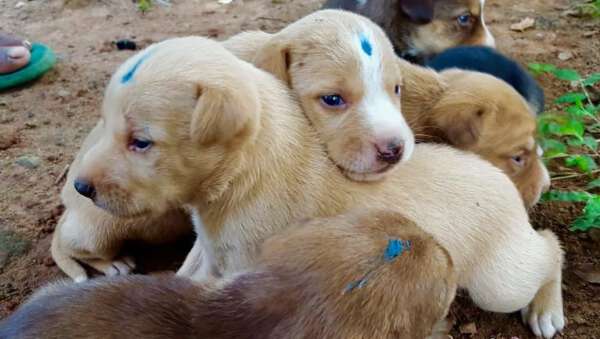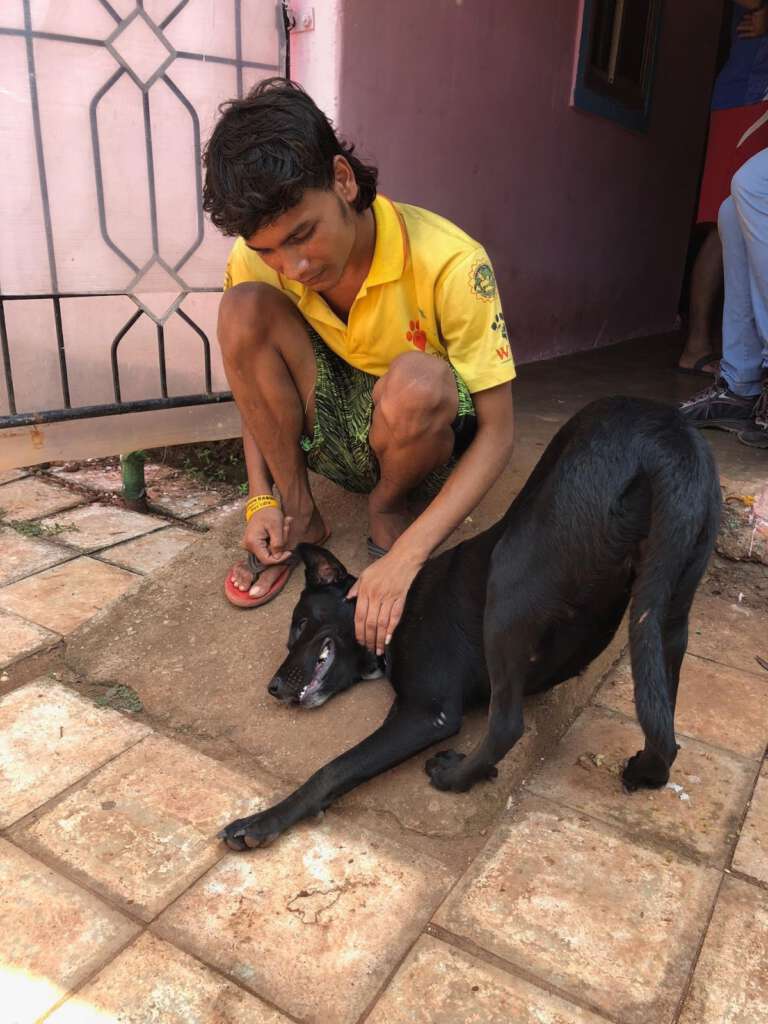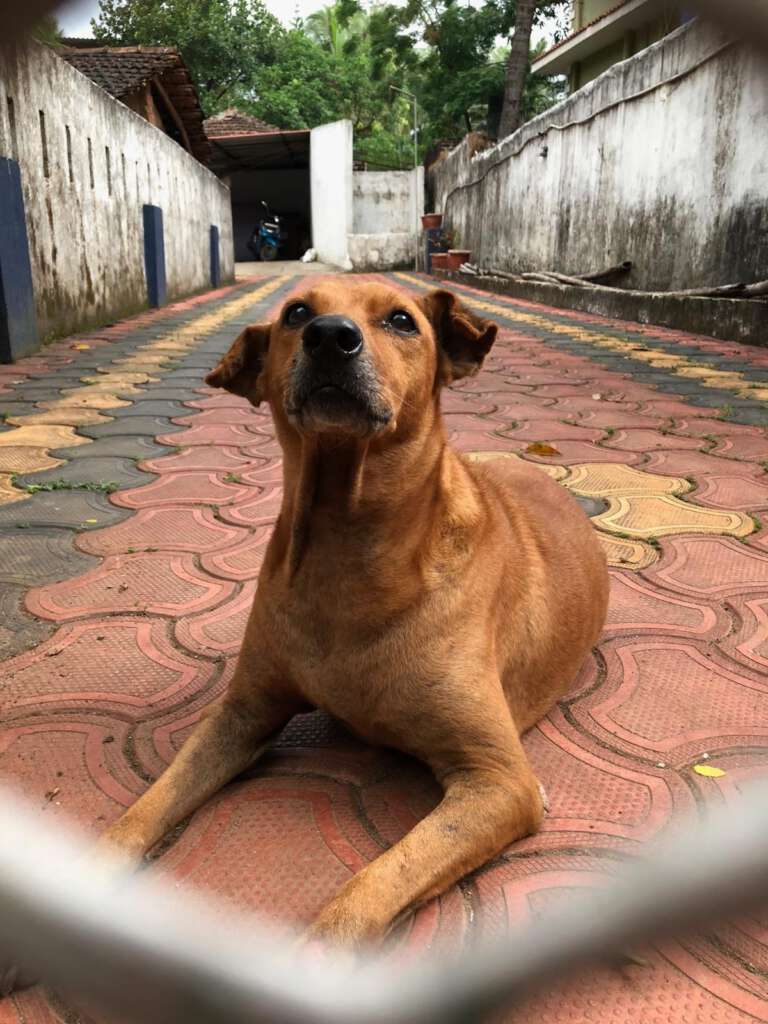
Mission Rabies Goa – Chapter 13: Catching and Vaccinating the Dogs and Puppies
There are so many enjoyable aspects of the Mission Rabies Goa vaccination drive (Here’s their Facebook Page; give em a ‘like’). I loved meeting and bonding with my fellow volunteers. Driving through Goa and walking the streets and alleys was fascinating. Sampling Indian breakfast cuisine at the different roadside cafés was great. Meeting and chatting with the residents of Goa was totally awesome. But as a veterinarian, working with animals is in my DNA, and interacting with the dogs has to be at the top of the list of favorite activities.
Most of the dogs that we target are strays. These dogs can be found anywhere and everywhere. They roam the streets, sleep in rice fields, and romp in the sand on the beach. The teams go to where they’re known to congregate and they try to catch them with nets.
Once caught, someone (usually me or Alyssa) would vaccinate them, paint their head, and let them go.
A second population can be classified as owned. These dogs wear a collar, live in a home, or in their yard, or they hang out nearby, and have a name. We engage these dogs by going house by house, door to door. If the dog isn’t in the house, they often can be summoned by the owner just by calling. Most of these dogs can be held by the owner, or by one of the handlers, while the dog is being vaccinated.
Some of these owned dogs are friendly, but they still won’t let you restrain them for you to be able to give them a vaccine, and the owners are also unable to hold them steady. Some of those dogs will require the net, just to keep them still.
Once they’re in the net, they’re easily vaccinated.
There’s a third population of dogs that we call “semi-owned”. These are community dogs. They hang around a particular area or neighborhood and are fed by one or several residents. Everyone knows them, but no one technically owns them. I’ve been to homes where three dogs are present, but only two of the dogs are considered to be owned. “He’s been coming here for two months now”, the resident will tell me, “but he’s not ours.” What I’ve noticed, after my stint with Mission Rabies, is that the collar says it all. If they slap a collar on the dog, they own it. In that home with three dogs, the owned dogs had collars. The third dog’s neck was naked. On the first day of our second week, we went door to door in a suburban area, to vaccinate. We went to one man’s home. He pointed to a dog nearby and said that she needed a rabies vaccine.
“Are you her owner?”, we asked.
“No,” he said. “We just feed her.”
“Did you put that collar on her neck”, I asked him.
“Yes”, he said.
“Does she have a name?”
“We call her ‘Sweetie’”, he said.
“If she’s got a collar and a name, she’s your dog”, I said, smiling. He laughed. “I guess she is”, he said proudly.
Speaking of names, I have to say that Indians are the least creative people when it comes to naming dogs. I’d say about 90% of black dogs are named Blackie. Most brown dogs are named Brownie. And as you might have guessed, a pretty high percentage of white dogs are named (wait for it….) Whitey. I’ve seen a few not-very-creative variations, such as Blacko. I met one owner had named his black dog Blacker and the brown dog Browner. One guy brought out three dogs for vaccination. Two were brown, one was white. We vaccinated the white one, Whitey, first. Then we did Brownie next. I was curious to know the name of the third one. “Brownie”, he said. “You named both of your brown dogs Brownie?”, I asked. He just smiled sheepishly.

Guess this dog’s name 
how about this dog?
For some reason, Tommy is an especially popular name for male dogs, as is Tyson. Sweetie is probably the next most common name for female dogs, after Blackie and Brownie. Snoopy is also a very popular name. And then, occasionally, you’ll get other names, like Rambo or Monica, but not too often.
The stray dogs vary widely in appearance, although the most common phenotype seems to be the lean 40 pound short-haired tan dog. Many resemble Pharoah hounds in appearance, interestingly.
The shades of tan run the gamut from very light (almost white), to dark brown. There are many black dogs, as well. And there are lots of combinations: tan and white, black and white, black and brown. You name it, you’re bound to see it.
As for temperament, most of the stray and semi-owned dogs are very sweet. Understandably, being pursued and surrounded by young men holding nets causes them to be fearful once they’re caught, and many of them vocalize and struggle while in the net. Most calm down in less than a minute, and we can then easily vaccinate and release them. I always find it amusing when a netted dog raises a fuss during the vaccination, and then, after being released, dashes away for about 10 yards before turning back and lingering around us. If you call these dogs, they come over to you cautiously, tail wagging, and then let you pet them, like the two dogs below. I vaccinated them, we painted their heads, they dashed off, and then came back, tails wagging, and wouldn’t leave us alone!
See for yourself!
Sometimes, after you net and vaccinate a dog, rather than dash off, it will actually follow you for a few minutes. It’s pretty charming. A few follow us for quite a while!
Some dogs that follow us are maybe a bit too friendly. This black dog wanted to play with Frank so badly that he jumped up on him, knocking the cellphone out of Frank’s hand and cracking the screen.
These dogs don’t hold a grudge. In fact, we’ll often canvass the same area the next day, to try to capture the ones that we missed the day before, and quite often we’re greeted enthusiastically by a dog with a brightly visible paint spot on its head. It’s as if they’re saying to us, “You got me yesterday, so now we can be friends.”
A significant percentage, however, are clearly not socialized to humans. They either continuously thrash in the net, or they completely freeze up. We prefer the latter response, of course, as it allows us to get the job done faster and release them more promptly. These dogs hightail it out of there the moment we open the net, and they never look back.
Most of the dogs we vaccinated were pretty healthy looking. Some had issues, though, the most common being skin disease. Seeing dogs with mange was pretty routine. Not surprisingly, a number of dogs were underweight, but much less than I expected. These dogs do pretty well for themselves, and people treat them kindly. I saw a few dogs favoring a leg. Some dogs, sadly, were lame to the degree that they held one leg up, unable to bear weight on that leg at all. Thankfully, these dogs were in the minority.
During the second week, we caught a dog in a net and we vaccinated her. While she was in the net, we noticed some discharge around her neck. We suspected an abscess.
She didn’t put up much of a fight when we initially netted her, nor when we started to examine her. I don’t know if she knew that we were trying to help her, or if she was just feeling weak from being a bit ill. As we examined her more closely, we saw that she had a small laceration on the side of her neck, and it looked a bit infected.
We cleaned it up as best we could on the spot, and then decided that she probably needed further treatment at our veterinary center.
We loaded her into the cage that we keep in the back of the truck, and brought her back to the hotel, where another truck transported her to the clinic. I fed her some treats while she was in the cage. She was interested in them, which is a good sign.
Another interesting case concerned this dog that we saw on the street. I spotted this dog walking pretty close to the traffic on the street. It was obvious that this dog had some type of neurologic disorder, with these steady, rhythmic muscle contractions.
It looked like distemper, but rabies does affect the nervous system and this had to be a consideration. Frank made a few phone calls, getting opinions from some of the higher-ups as to whether this dog needed to be caught and transported to our facility. We were keeping our distance from the dog, but also staying close enough to make sure she didn’t go running off. While we were waiting for instructions, a man walked over to the dog and picked her up and started walking away with her! We shouted, “No! Don’t touch her!” He looked at us puzzled. “She’s my dog!”, he said. We were very surprised that she had an owner. “She had distemper, but she recovered.” I asked him how long she had been like this, with the twitching. “Four years”, he said. We were amazed that she survived the distemper, and were also impressed with the owner’s devotion to the dog. He said that she does remarkably well. He even pointed to another dog in his shop. “That’s her daughter”, he said.
Let me tell you about the most gratifying case of the trip (for me, at least). One day, our team was on stray patrol, searching for unowned dogs in one particular neighborhood. A dog was trotting along nearby, but it had a blue collar on. Frank said there was no need to chase down that dog, because there is another team in the area that is catching dogs that are owned, and that they would undoubtedly capture and vaccinate that one. As the dog passed by, I noticed that the blue collar wasn’t a collar at all. It looked like a piece of plastic that was around the dog’s neck pretty tightly. I said to Frank, “That’s not a collar. That’s some kind of band or piece of plastic!” The handlers grabbed their nets and tried chasing after her, but there was a big field nearby and she made a dash for it and was quickly out of sight. I thought about that dog for the entire rest of the afternoon and evening.
The next morning, we were canvassing the same neighborhood for strays. As soon as the truck started slowing down to park, the boys on the truck spotted a dog not too far away, and they grabbed their nets and took off after it. We parked the truck and ran after the handlers. We caught up with them about two minutes later. They had caught the dog. I went over and lo and behold! It was the dog that I had seen the day before. She had a thick blue plastic ring around her neck. I have no idea how it got on her. It was tight, but not constricting. It was clearly uncomfortable, though. First, we vaccinated her.
Then we took a pair of thick scissors and cut it off. We caught it all on video, too. Have a look.
She was remarkably calm through the entire episode, and when we were done and we opened the net, she didn’t run off.
She seemed to like the attention that she was getting. Getting that band off of her neck really made my day.
One of the nicest things about this mission was working with the animal handlers.
The animal handlers are local boys from North India. They range in age from 18 to 25, typically. Mission Rabies provides them with housing, food, and a salary. They reside in a rooming house not far from the hotel. They’ve been taught about the mission and are well trained in catching dogs with the net.
Although these guys catch dogs in the hot sun all day long, day after day, week after week, they really don’t seem jaded to me. They’ve caught, vaccinated, and have dealt with thousands of dogs, and yet they still find the time to pat, play with, and fuss over some of the dogs they encounter. Their affection for the dogs is heartwarming, and it left me very impressed. Here are just a few examples of this that I caught with my camera.
While it’s tempting to think of the animal handlers like the sherpas that take the mountaineers up Everest, it’s not an accurate analogy. With mountaineering, the sherpas do all the work, while the climbers get the glory. At Mission Rabies, however, the handlers aren’t unsung heroes. The volunteers sang their praises daily, as did the Mission Rabies staff. The handlers seemed well aware of how much we respected and admired them, and I’m sure this helped keep them motivated.
Our team leader, Frank, was amazing. He was in charge of our group, the Leopards, and he was an excellent leader. He struck the perfect balance of being one of the guys, yet commanding the respect of the rest of the team, with his style of gentle discipline and leadership. I think the team leader sets the tone for the entire mission, and Frank was the perfect combination of serious yet fun, driven yet relaxed. He was motivated and dedicated, and I admired him greatly.
Plus, Frank was a real softie when it came to puppies. It was fun to watch him melt at the sight of them.
Speaking of puppies… most of the dogs we vaccinated were adults. But we did come across puppies fairly frequently. That certainly brightened up our day. I mean, come on… who can resist puppies?! And when puppies showed up, the camera came out.
Here’s some interesting puppy footage: A woman told us that there were some puppies in a hole in a tree. The hole was big enough for the mother to get inside, and she felt it was a safe place for her to have her puppies. We had to walk through some interesting yards to get to the tree and the pups. So cute!
As I mentioned, Frank can’t resist puppies. Here he is with one of the tree pups.
We also have some dramatic puppy footage. A local resident reported that some puppies were stuck in a drainage ditch. The space was narrow and not easy to access. One of the handlers, Ajay, agreed to crawl in there and see if he could grab them. It was muddy and wet in there, but we put a burlap sack on the ground for him to crawl on, and he managed to get in there (the advantages of being thin) and pull out a few healthy-looking pups.
Once again, where there are puppies, you’ll find our leader Frank. He vaccinated the little pups from the drainage ditch.
All good things must come to an end, and my next post will be the final one, in which the volunteers say goodbye to Goa, goodbye to the handlers, and goodbye to each other.
Next Post – Chapter 14
I am delighted to announce that in February 2020, I will once again be joining a team of Mission Rabies volunteers on another vaccination drive. The destination: Ghana! Our intention, as always, is to vaccinate as many dogs as possible, with a goal of immunizing 70% of the dog population. At this level of immunity, the rabies cycle is broken. To do this type of work is expensive and requires many resources. If you support the work that I am doing with this amazing organization, I ask that you make a donation to the cause. Every dollar helps.

